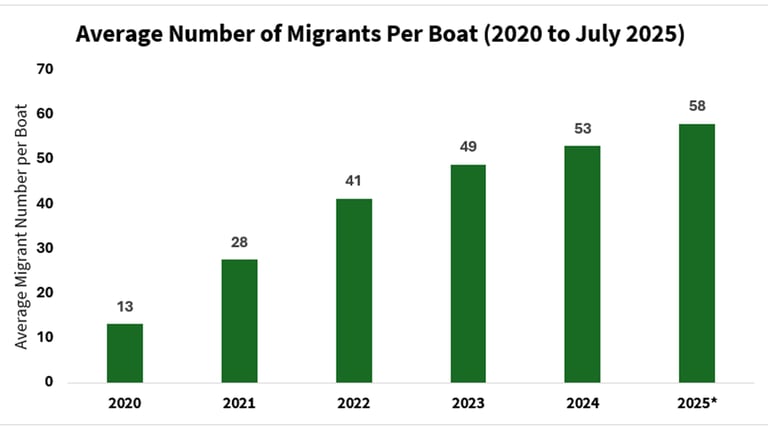Channel: Migrants per Boat Doubled Since 2021
By mid-July 2025, the number of migrants per boat had reached an average of 58 migrants per boat.
The average number of migrants per boat is now more than double the number per boat in 2021 (28) and 9 percent higher than the number per boat in 2024 (53.)
The number of migrants per boat has increased every year since statistics on the numbers were collected. The average number of migrants per boat has increased from 28 (2021), 41 (2022), 49 (2023), 53 (2024), to 58 (mid-July 2025.)
The more migrants per boat, the higher the risk of migrant drownings in overcrowded, overloaded boats.
As more migrants per boat arrive, this means that even if boat numbers decrease, the number of migrants may not, and with it pose more challenges for service provision.
Download the full paper here, or read online below.
Channel: Migrants per Boat Doubled Since 2021
Analysis of Home Office data shows that an average of 58 migrant per boat was being detected in the Channel. This is more than double the average of 28 migrants per boat in 2021, and up 9 percent from the 2024 figure.
Executive Summary
Much of the debate on Channel migrants has focused on the boats as the unit of analysis, rather than the more pertinent unit i.e., the people in them. The number of migrants per boat has risen significantly. This increases the risk of migrant drownings, as overloaded boats are less stable on the sea. A single boat with 50 migrants poses greater challenges than a single boat with just 10 people aboard. As UK and French authorities focus on stopping boats, smugglers appear to be forcing more migrants into each boat, and therefore, each boat that can evade French authorities at the port of departure will have a bigger impact upon arrival in the UK.
The UK government records two statistics of interest: the “number of arrivals” (i.e., the number of migrants), and the “number of boats.” Both the number of boats and the number of migrants have surged since the pandemic. The data show that each boat is now carrying over four times the number of migrants that the boats were carrying in 2020, and double what they were carrying in 2021, when border restrictions worldwide relaxed and migrant flows began to resume. The average number of migrants per boat has increased from 28 (2021), 41 (2022), 49 (2023), 53 (2024), to 58 (mid-July 2025.)
Implications for Migrants
Overloaded boats in any environment are a serious safety hazard. This is particularly pronounced in the context of irregular migration, where journeys are often launched in low light and/or with faulty life jackets, compounding the risk. At least 244 migrants have died or gone missing while attempting to cross the English Channel between 2018 and 2024 according to international data, with 2024 being the deadliest year with 85 deaths (iii). Overloaded boats only increase the risk of these numbers increasing.
Implications for Law Enforcement
Migrants are disproportionately young men from war zones. Drug and alcohol use in migrant camps, often in conjunction with pre-existing mental health challenges, could create a situation where intercepting boats is more dangerous, given the increasing numerical disparity between first responders and migrants.
Implications for Public Services
Even if overall boat arrivals were to decline, the increasing number of migrants per boat means that the impact grows. Ultimately services like housing, translation, health, legal fees, and other costs are not accrued by boats, but the people in them. The more people, the more costs, even if boat numbers decrease.
Implications for Political Debate
Politicians on both sides of the Channel increasingly feel the need to tackle “the boats”, and any reduction in the number of boats could be proclaimed a policy success. However, the real public policy challenge is not the boats but the number of people on them. If the number of boats reduces, but the number of migrants per boat increases, this could give rise to accusations of cynicism and reduce public confidence.
Orunmila Research is a consultancy specializing in migration analysis, international affairs, and geopolitical risk. We provide independent, evidence-based, data-driven analysis at the intersection of migration, conflict, and policy. We help governments, NGOs, and institutions understand the deeper, complex drivers behind border movements and instability to allow for a more informed and impactful debate.
Insights
Specializing in migration research.
info@orunmilaresearch.com
© 2025. All rights reserved.
We use AI-generated images for illustration purposes only. To protect the privacy and dignity of migrants, and to comply with local laws in places we operate and research, no photos of real individuals are used. All research and analysis is 100% human-generated.


